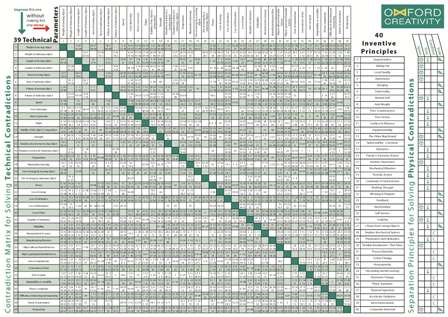Language/Multiple-languages/Culture/How-to-be-Creative
If we look at our surroundings, we can find potential improvements in our life. They are mostly trivia, however, they are many. In language learning, the skill of creation also helps.
In this lesson, we will learn about the theory of inventive problem solving, and then see how it can be applied to language learning.
In progress
In the college as an undergraduate, I took the course “TRIZ”. It is the initialism for “теория решения изобретательских задач”, theory of inventive problem solving. TRIZ is used mostly in engineering, especially in mechanical engineering. It is created by Genrich Altshuller, who gathered ideas of innovations and tried to find out their patterns. His works were seen by Joseph Stalin, then he was sent to a labour camp. After Khrushchev Thaw took power, he was freed and his ideas started to be valued.

Contradiction Matrix[edit | edit source]
There are several methods to try to innovate. The most prominent one is the “contradiction matrix”, which is accompanied by 40 principles. If you want to improve one aspect and keep another aspect unchanged, then you can find the corresponding cell for these two values in the matrix, with the aspect to be improved as the row and the aspect to be kept as the column. There are numbers in a cell, which are the corresponding numbers of the 40 principles. Then you can try to innovate with the principles in the cell.

A PDF version is here:
For example, if you would like to increase your productivity and keep the reliability, then you can find the corresponding cell with 01 35 10 38. According to 01 “division”, you may divide your tasks into smaller goals; according to 35 “changing state, parameters, properties of materials”, you may eat well, sleep well, have a good mood; according to 10 “pre-eliminary action”, you may move distractions out of your reach; according to 38 “strong oxidants”, you may drink some hydrogen peroxide and die, or seriously: keep the oxygen gas in your room high, which means to ventilate, or even understand it psychologically: get inspired.
Nine Windows[edit | edit source]
This method is for tasks around a system in different dimensions. Consider the system and its subsystem and supersystem at present, in the past and in the future.

For example, if I would like to find resources for studying a language, I would find materials for the language I am going to study, which is the present system; I can also find materials for linguistics or specific topics like irregular verbs, which are the supersystem and subsystem; I can also find old materials like dictionaries over a hundred years ago and upcoming materials like augmented reality, which are the past and future.
Trial and Error[edit | edit source]
It is simple. Just try out possible solutions. In the 19th century, many inventions are invented this way. Today, machine learning is also based on it.
In language learning, it means to speak to native speakers and get the feedback from them.
Other Lessons[edit | edit source]
- Best Guitarists
- Most Famous Folk Songs
- Ideas about language learning
- Unrealistic War Films and TV Series
- Natural phenomena
- Writing Implements
- Websites of DIY Procedures
- Internet Dictionaries
- Video Games with Real‐Life Occupations
- Soramimi List
